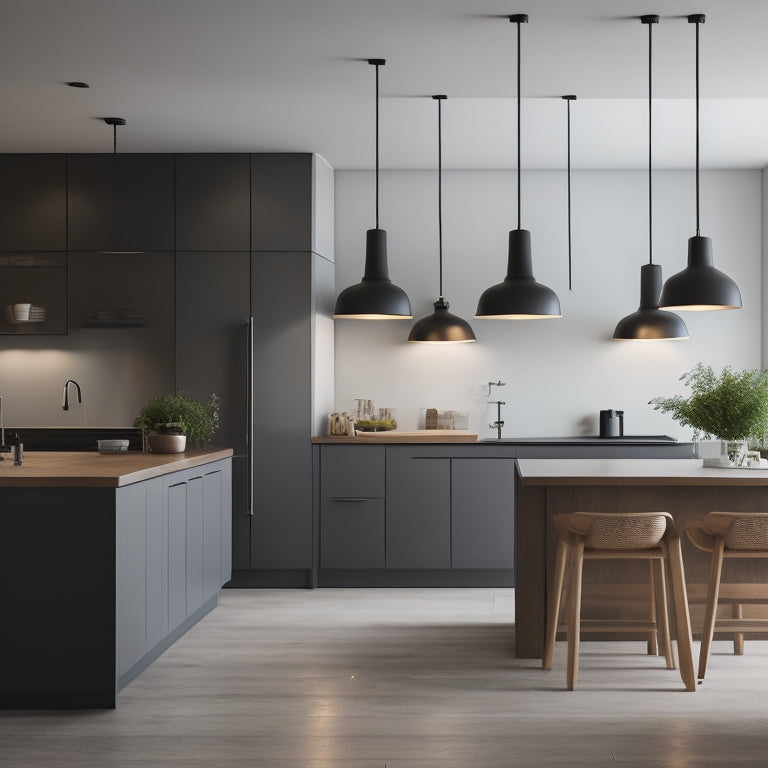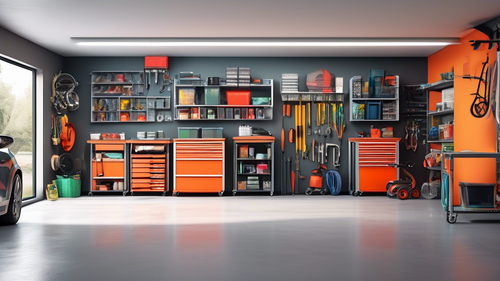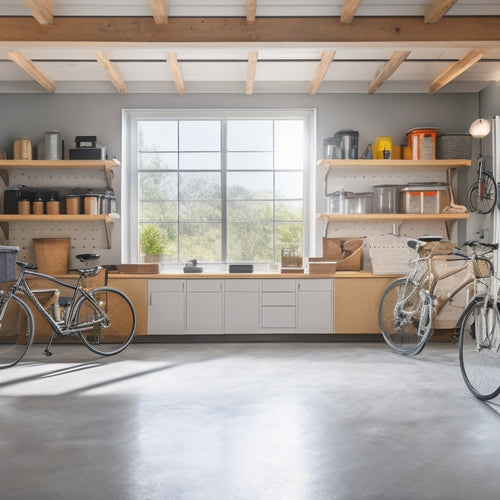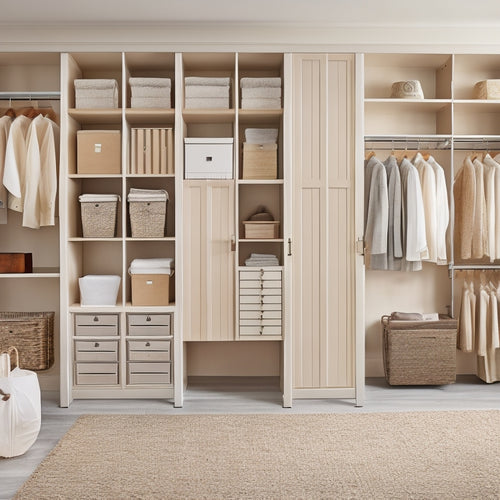
What Makes a Kitchen Truly Minimalist Anyway?
Share
You're about to transform your kitchen into a serene and functional oasis by understanding the essential elements that define a truly minimalist kitchen space. A minimalist kitchen emphasizes simplicity and restraint through a limited color palette and sparse ornamentation. It's all about optimizing space with a functional layout, incorporating the 'work triangle' concept, and achieving an overall sense of calm. You'll eliminate visual clutter by organizing utensils and decluttering cabinets, and simplify your cooking routine with multifunctional tools and simple color schemes. As you continue, you'll uncover the secrets to a truly peaceful and efficient kitchen.
Key Takeaways
• A truly minimalist kitchen emphasizes simplicity and restraint in design, eliminating non-essential elements and visual clutter.
• A functional layout is crucial, focusing on space optimization and the "work triangle" concept for easy movement and workflow.
• A limited color palette and sparse ornamentation create a sense of calm, with an emphasis on textures and shapes over bold colors.
• Investing in multifunctional tools and decluttering utensils and cabinets help streamline cooking routines and maintain order.
• The elimination of cluttered corners and countertops creates a sense of visual expansion and tranquility, allowing for effortless movement and mental clarity.
Defining Minimalist Kitchen Design
As you envision your ideal kitchen, you're likely drawn to the clean lines, simplicity, and functionality that define a minimalist kitchen design. This aesthetic is all about stripping away the clutter and focusing on what truly matters. Minimalist decor is key, with an emphasis on simplicity and restraint. You'll often find a limited color palette, sparse ornamentation, and an overall sense of calm.
A functional layout is also essential in a minimalist kitchen. This means optimizing your space to maximize efficiency and flow. You'll want to take into account the 'work triangle' concept, where your sink, stove, and refrigerator form the points of a triangle, making it easy to move between tasks.
Streamlining Kitchen Essentials
As you begin to streamline your kitchen essentials, you'll need to pinpoint the tools that truly matter.
Take stock of your kitchen drawers and countertops – what gadgets and gizmos do you reach for daily, and which ones collect dust?
Essential Kitchen Tools
Streamlining your kitchen essentials begins with identifying the essential tools that'll help you cook, prep, and serve with ease. You don't need a cluttered kitchen to excel at cooking. Concentrate on the essentials that'll have an impact on your cooking journey.
Invest in space-saving gadgets such as a compact stand mixer, a silicone spatula set, and a wall-mounted knife block. These tools won't just save you space but also enhance your cooking efficiency.
Effective kitchen organization is crucial for a minimalist kitchen. Allocate a specific spot for each tool, and make certain everything is easily accessible. Set up a pegboard on a wall or the rear of a cabinet door to hang frequently used items like pots, pans, and utensils. Label each area to uphold order and guarantee that everything has its assigned position.
Simplified Cooking Routines
By paring down your cooking routines, you'll free up mental energy to focus on the creative aspects of cooking and enjoy the process more. Simplified cooking routines allow you to streamline your meal planning, eliminating the stress of deciding what to cook every day. With a clear plan, you can shop smart, reducing food waste and saving time.
Time-saving recipes are an essential component of simplified cooking routines. Look for recipes that use common ingredients, require minimal prep time, and can be cooked in under 30 minutes. One-pot wonders, sheet pan meals, and slow cooker recipes are great options. These recipes will become your go-to's, allowing you to cook with confidence and ease.
Eliminating Visual Clutter
Your kitchen countertops, once a haven for KitchenAid stand mixers, coffee makers, and toasters, now resemble a cluttered electronics store, making it difficult to focus on the task at hand. It's time to eliminate visual clutter and regain control of your cooking space.
Here are 3 reasons why you should take action:
-
You can't think straight: Cluttered countertops lead to mental fatigue, making it hard to focus on meal prep or cooking.
-
You're wasting time: Digging through cluttered cabinets and drawers to find what you need is a huge time-suck.
-
You're compromising hygiene: Cramped and cluttered spaces are breeding grounds for bacteria and germs.
To eliminate visual clutter, start by organizing your utensils. Assign a designated spot for each item, and consider investing in a utensil organizer or divider.
Next, declutter your cabinets by categorizing items into 'keep,' 'donate,' and 'discard' piles. Be ruthless – if you haven't used it in the past year, it's probably safe to let it go.
Opting for Simple Color Schemes
As you design your kitchen's color scheme, you'll find that simplicity is key to achieving a minimalist aesthetic.
By choosing a neutral background, you'll create a clean canvas that allows your kitchen's functional elements to take center stage.
From there, you can introduce a single bold hue or variations of a single color to create a sense of monochromatic harmony.
Neutral Backgrounds Prevail
Neutral backgrounds take center stage in a minimalist kitchen, allowing your eyes to focus on the clean lines, shapes, and textures of the space. This deliberate design choice creates a sense of calmness, making it easier for you to appreciate the beauty in the simplicity of your kitchen.
In a minimalist kitchen, a neutral color palette is essential. It provides a clean canvas for your decorative pieces to shine.
Here are three ways a neutral background can elevate your kitchen's aesthetic:
-
Accentuates textures: A neutral background highlights the varying textures of your kitchen's materials, such as the smoothness of quartz countertops or the roughness of reclaimed wood.
-
Creates visual flow: A consistent neutral tone enables your eyes to move seamlessly throughout the space, creating a sense of continuity and harmony.
-
Showcases minimalist decor: A neutral background puts the spotlight on your carefully curated decorative pieces, allowing them to take center stage and tell their own story.
Monochromatic Harmony Reigns
By embracing a single hue or a limited palette, you create a sense of monochromatic harmony that visually ties together the various elements of your kitchen, from cabinetry to countertops. This deliberate choice simplifies the visual landscape, allowing your eyes to move effortlessly throughout the space. A minimalist decor is elevated by the absence of clashing colors, creating a sense of calm and serenity.
Monochrome accents, such as matching appliances or fixtures, further reinforce this visual cohesion. The result is a kitchen that exudes sophistication and refinement.
By limiting your color scheme, you're able to focus on the textures, shapes, and forms of each element, rather than being distracted by a riot of colors. This thoughtful approach to design enables you to create a kitchen that's both aesthetically pleasing and highly functional.
As you navigate the space, you'll appreciate the sense of continuity and flow that monochromatic harmony provides. By embracing simplicity, you're able to open a kitchen that's truly greater than the sum of its parts.
Investing in Multifunctional Tools
Within a kitchen minimalist's arsenal, a few well-chosen multifunctional tools can efficiently tackle a multitude of tasks, freeing up valuable counter and storage space. By investing in these space-saving gadgets, you'll be able to declutter your kitchen and create a more streamlined cooking experience.
Here are three must-have multifunctional tools to get you started:
-
Instant Pot: This versatile appliance can pressure cook, slow cook, sauté, steam, and even make yogurt, replacing multiple devices and saving you precious counter space.
-
KitchenAid Stand Mixer: With its various attachments, this mixer can whip, knead, and mix ingredients with ease, making it a valuable addition to your minimalist kitchen.
-
Silpat Non-Stick Baking Mat: This mat can be used for baking, roasting, and even as a makeshift pastry mat, reducing the need for multiple baking sheets and utensils.
Prioritizing Negative Space
As you reimagine your kitchen space, remember that it's not just about what you add, but what you subtract.
You're aiming to create a sense of breathability, where your eyes can rest on empty areas and clear corners.
Empty Areas Matter
You'll notice that cluttered kitchens often feel overwhelming, but it's the empty areas that create a sense of calm and visual flow. A truly minimalist kitchen isn't just about removing clutter, but also about intentionally designing empty spaces to create a sense of breathability.
When you prioritize negative space, you're creating an environment that's not only visually appealing but also highly functional. A well-designed kitchen with ample empty areas allows for:
-
Effortless movement: With a clear path, you can move freely around the kitchen, making cooking and socializing a breeze.
-
Visual balance: The empty spaces create a sense of harmony, drawing your attention to the beautiful minimalist decor.
-
Mental clarity: The lack of clutter reduces mental fatigue, allowing you to focus on the task at hand.
Clearing Cluttered Corners
By strategically clearing cluttered corners, you create pockets of negative space that visually expand the kitchen, making it feel more spacious and organized. This is where the magic of minimalism happens.
As you declutter, you'll notice areas that were once cramped and chaotic transform into tranquil zones that invite relaxation.
Start by tackling those pesky corners where appliances, cookbooks, and utensils tend to accumulate. Organizing drawers and clearing pantry shelves will help you purge unnecessary items and make the most of your storage space.
Consider installing corner shelves, carousels, or lazy susans to maximize accessibility and visibility. These clever solutions will keep your essentials within easy reach while keeping the countertops clear.
Creating a Clutter-Free Countertop
Your countertops are a blank canvas, waiting for a curated selection of essentials that spark joy and facilitate effortless meal prep. By paring down to the bare essentials, you'll create a space that's both aesthetically pleasing and highly functional.
Here are the top 3 must-haves for a clutter-free countertop:
-
A statement piece: A stylish vase, a decorative bowl, or a minimalist coffee maker that adds visual interest and personality to your space.
-
A utensil organizer: A sleek container that keeps frequently used items, such as olive oil, salt, and pepper, within easy reach.
-
A prep station: A compact setup, like a cutting board and knife block, that streamlines meal prep and keeps countertops clear.
To achieve this look, focus on organizing utensil drawers and clearing pantry shelves to free up space. By doing so, you'll create a sense of calm and control in your kitchen, making meal prep a breeze.
Utilizing Hidden Storage Solutions
Now that your countertops are clutter-free, it's time to maximize your kitchen's hidden potential by incorporating clever storage solutions that keep items out of sight yet easily accessible.
To create a truly minimalist kitchen, you'll want to utilize hidden storage solutions that maintain a sense of openness while keeping essentials within reach. Consider incorporating concealed compartments, secret storage, and clever cabinetry to keep your kitchen organized and clutter-free.
Here are some ideas to get you started:
| Storage Solution | Description |
|---|---|
| Pull-out pantries | Install slide-out shelves or drawers to store spices, oils, or cooking utensils. |
| Hidden appliance garages | Conceal small appliances, like toasters or blenders, behind doors or panels. |
| Under-sink storage | Utilize the space beneath your sink for storing cleaning supplies or accessories. |
| Faux cabinet doors | Design cabinets with fake doors that swing open to reveal storage compartments. |
Simplifying Kitchen Lighting Fixtures
Three key types of lighting - ambient, task, and accent - can be cleverly combined to create a simplified yet effective kitchen lighting scheme that illuminates your cooking space without visual clutter. By striking the right balance, you'll create a space that's both functional and visually appealing.
Here are three ways to simplify your kitchen lighting fixtures:
-
Opt for minimalist pendants: Sleek, dimmable options can provide task lighting over islands or countertops, adding a touch of sophistication to your space.
-
Install undercabinet lighting: This subtle yet effective lighting solution eliminates harsh shadows, creating a sense of openness and airiness in your kitchen.
-
Use recessed spotlights: Strategically placed spotlights can highlight specific design elements, such as a stunning backsplash or a beautiful range, drawing the eye to these focal points.
Embracing a Calming Atmosphere
Beyond the functional essentials, a calming atmosphere in the kitchen is cultivated by carefully selecting a harmonious color palette, textures, and materials that soothe the senses.
As you design your minimalist kitchen, consider the principles of Feng Shui, which emphasize balance and harmony to promote a sense of calm. Neutral tones, such as white, gray, and beige, can create a serene backdrop for your kitchen. Add warmth with natural materials like wood and stone, and incorporate textiles with subtle patterns to avoid visual clutter.
To maintain a sense of clarity, keep countertops and surfaces clear of clutter. A minimalist space should evoke feelings of serenity, so edit your decor carefully. A few, carefully chosen pieces can add visual interest without disrupting the calm atmosphere.
Consider adding some greenery, like a small potted plant, to bring in a touch of nature and freshness. By embracing a calming atmosphere, you'll create a kitchen that's not only functional but also a haven for relaxation and rejuvenation.
Frequently Asked Questions
Can a Minimalist Kitchen Still Be Warm and Inviting?
You can create a warm and inviting minimalist kitchen by incorporating cozy aesthetics, such as natural materials and soft lighting, to craft a warm ambiance that makes you feel comfortable and relaxed.
How Do I Balance Minimalism With Kitchen Functionality?
"You balance minimalism with kitchen functionality by choosing storage solutions that blend seamlessly into your design aesthetic, ensuring practicality doesn't sacrifice style, and cleverly incorporating functional elements that elevate your space's overall look."
Are Minimalist Kitchens Only for Modern Architectural Styles?
You can create a minimalist kitchen in any style, from sleek modern to warm traditional designs, by embracing simplicity and restraint, even adding vintage charm through carefully curated decorative elements.
Can I Still Display Personal Items in a Minimalist Kitchen?
You can still add a personal touch to your minimalist kitchen by thoughtfully displaying sentimental items that complement the design, striking a balance between emotional connection and a clean, minimalist aesthetic.
Is a Minimalist Kitchen More Expensive to Design and Build?
You'll need to balance budget considerations with design simplicity to achieve a minimalist kitchen. While sleek aesthetics may come at a cost, you'll reap cost savings from reduced material usage and a focus on function over form.
Related Posts
-

Maximize Your Garage Space: A Comprehensive Guide
Decluttering and organizing your garage can seem like a daunting task, but it's a worthwhile investment that will...
-

Why Garage Storage Matters in Home Decor
As you reimagine your living space, don't underestimate the garage's impact on your home's value, your mental well-be...
-

What Makes a Closet Organization System Efficient?
You achieve an efficient closet organization system by understanding your space, purging clutter, and categorizing be...


